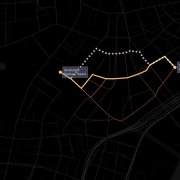We seem to be wired to calculate not the shortest path but the “pointiest” one, facing us toward our destination as much as possible.
Anne Trafton | MIT News Office
Everyone knows the shortest distance between two points is a straight line. However, when you’re walking along city streets, a straight line may not be possible. How do you decide which way to go?
A new MIT study suggests that our brains are actually not optimized to calculate the so-called “shortest path” when navigating on foot. Based on a dataset of more than 14,000 people going about their daily lives, the MIT team found that instead, pedestrians appear to choose paths that seem to point most directly toward their destination, even if those routes end up being longer. They call this the “pointiest path.”
This strategy, known as vector-based navigation, has also been seen in studies of animals, from insects to primates. The MIT team suggests vector-based navigation, which requires less brainpower than actually calculating the shortest route, may have evolved to let the brain devote more power to other tasks.
“There appears to be a tradeoff that allows computational power in our brain to be used for other things — 30,000 years ago, to avoid a lion, or now, to avoid a perilious SUV,” says Carlo Ratti, a professor of urban technologies in MIT’s Department of Urban Studies and Planning and director of the Senseable City Laboratory. “Vector-based navigation does not produce the shortest path, but it’s close enough to the shortest path, and it’s very simple to compute it.”
Ratti is the senior author of the study, which appears today in Nature Computational Science. Christian Bongiorno, an associate professor at Université Paris-Saclay and a member of MIT’s Senseable City Laboratory, is the study’s lead author. Joshua Tenenbaum, a professor of computational cognitive science at MIT and a member of the Center for Brains, Minds, and Machines and the Computer Science and Artificial Intelligence Laboratory (CSAIL), is also an author of the paper.
Vector-based navigation
Twenty years ago, while a graduate student at Cambridge University, Ratti walked the route between his residential college and his departmental office nearly every day. One day, he realized that he was actually taking two different routes — one on to the way to the office and a slightly different one on the way back...
Read the full story on the MIT News website using the link below.

